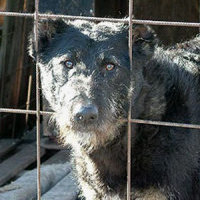 |
Sylvan Hound |
|
He is not recognized by the F.C.I. |
Origin |
Serbia | |
Translation |
Francis Vandersteen | |
This breed is also known as |
Sumadijski Gonic
|
| This wild dog is considered a simple hunting variety of the Serbian Sylvan Dog by some, while others believe that the Sumadijski Gonic constitutes a distinct breed, based on obvious physical differences and use. Although a number of breeders claim that the Sylvan Hound has always existed as a subtype of the Sumadinac breed with suggested roots found in old Russian, Indian, Iranian and Persian sighthounds, this working dog was probably developed with other hunting breeds from the region, such as the old Serbian sighthound, the Yugoslav mountain dog, the Slavonian sighthound, the Balkan dog, the Greek hare and others. Rare and little-known, the Sylvan Hound comes in a few varieties, ranging from tall, lean dogs belonging to the sighthound type to slightly smaller, stockier specimens, which are quite similar to the largest examples of the Balkan Hound in physical build. Used for hunting wild boar, deer, foxes and rabbits, this athletic breed also makes a competent breeder and protector of livestock, as well as being a very good watchdog. It is an excellent alarm dog, ready to back up its threats with action, making it markedly different from other European dogs of similar type. Sylvan Hounds are aloof with strangers, but not as aggressive as typical examples of the "standard" Sylvan Wolfdog breed. Appreciated for its courage and speed, the breed is a committed and tenacious hunter, but it can make a pleasant rural companion, thanks to its great devotion to its master and its love of children. The Sylvan is an intelligent, trainable dog, but some representatives can be rather stubborn and overly dominant, requiring early socialization, especially around other dogs, because the breed is naturally territorial and hostile towards foreign dogs. When raised in working packs, Sumadijski Gonic are less inclined to engage in combat with dogs, but can still be reserved around those not belonging to their hunting pack. Primarily bred for work, the breed has a loose appearance type, with function being prized more than form. Regional differences in size and build aside, all Sylvan dogs are muscular, strong and fast working dogs, some with docked tails. Ears can be set high or carried low, with some specimens semi-pierced and even perfectly erect. Cropping of the ears may have been practiced in the past, but the majority of modern representatives are unchanged. The coat is short, smooth and thick, always black or black-n-tan, with or without white markings. There is also a barbed variety, but these dogs are not as popular. The average size is around 63.5 centimeters, although greyhound-like examples can sometimes reach over 76 centimeters at the withers. |






 English (United Kingdom)
English (United Kingdom)